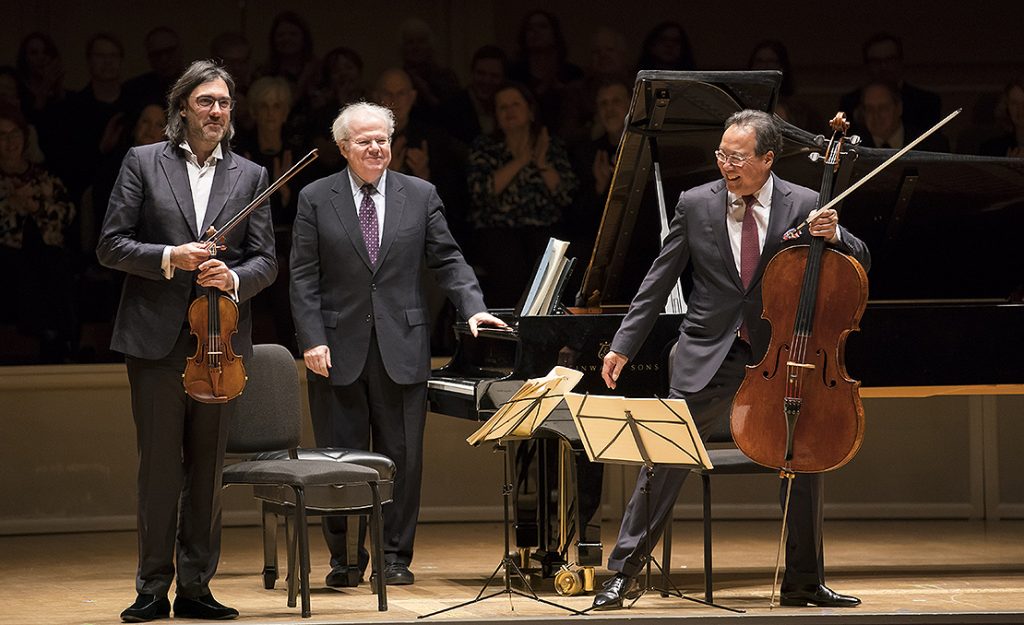
In the three decades since he won three major competitions over three years, Leonidas Kavakos has continued to soar. In 2017, the Greek violinist received the Léonie Sonning Music Prize, Denmark’s highest music honor. It has been awarded to such luminaries as Leonard Bernstein, Benjamin Britten, Simon Rattle and Mstislav Rostropovich.
In 2017-18, Kavakos is serving as artist-in-residence in not just one but two of the world‚Äôs most revered concert halls: Amsterdam‚Äôs Concertgebouw and Vienna‚Äôs Musikverein. Season to season, he regularly performs with many of the world‚Äôs great orchestras, including the Chicago Symphony Orchestra, with which he will serve as soloist March 8-11 in Shostakovich‚Äôs Violin Concerto No. 1¬Ýunder Emmanuel Krivine.
“It is a very satisfying situation,” Kavakos said from San Francisco. “The way the planning is designed gives me the possibility of doing artistically what I think I should be doing. I’m not somebody who likes the words ‘career’ and so on, even though they are very much realistic words. But somehow I don’t see it like that, because a career is like a race. For me, it’s not like this. It’s more like an artistic searching in order to be able to develop in the direction I believe I should be going as an artist and a human being.”

Leonidas Kavakos (from left), Emanuel Ax and Yo-Yo Ma take a bow after performing a Brahms trio. | ©Todd Rosenberg 2018
Kavakos’ elevated standing in the classical world is borne out by caliber of his collaborators: pianist Emanuel Ax and cellist Yo-Yo Ma, some of the most renowned artists in the field. He has known Ax since the 1990s, when they met and later performed recitals together. Ax and Ma are longtime friends, and Ax suggested to Ma that they should invite Kavakos to play trios with them.
The three first performed together at the Tanglewood Music Festival in Lenox, Mass., four or five years ago. After other concerts, the trio released a recording of the three Brahms piano trios on Sony Classical in September. On Feb. 21, they embarked on their first tour together: a nine-concert itinerary that ends March 4 in Disney Concert Hall in Los Angeles and has included stops at Carnegie Hall in New York City and Symphony Center in Chicago.
“From the very first few bars that we played together, it was very obvious that there was this chemistry that one dreams of,” Kavakos said. “You read through a piece for the first time, and you have the feeling that already that could have been a good performance.”
For the most part, the violinist sticks to the standard repertory, but sometimes he delves into a new work like Lera Auerbach’s Concerto for Violin and Orchestra No. 4, NYx: Fractured Dreams. He premiered it with Alan Gilbert and the New York Phiharmonic in March 2017 and performed it in October with the ORF Vienna Radio Symphony Orchestra.
“I’ve known Lera for quite a few years,” Kavakos said. “I think she is a composer who writes beyond music in a way. She’s an extremely profound person with enormous talent not only in music but also other fields. She is a sculptor, and she also paints. All this comes into her music. I find her music always to be extremely powerful and very characteristic.”
Some years ago, Kavakos asked her to set aside her next concerto for him. Before his residency at the New York Philharmonic last season, that request was fulfilled when he persuaded the orchestra to commission a work from Auerbach. “There it was — a concerto all of sudden,” he said, “which I thought was an extremely powerful piece, very effective for the audience and wonderful to play. Very challenging but also very rewarding. During the performance, it creates an amazing energy — that was the feeling that everybody got. This is a piece I’m going to be playing again and again.”
With the CSO, Kavakos will perform Shostakovich‚Äôs Concerto No. 1, originally written in 1947-48 and later revised; it’s a piece he has long admired but did not immediately embrace as a soloist. He was supposed to perform it for the first time some years ago, but he backed out at the last moment. ‚ÄúAs I started studying it, I was never happy with the sound I could produce for the slow movements,‚Äù he said.
After a few more years, he finally made his debut in the work at the 2010 Stresa Festival in Italy with conductor Gianandrea Noseda. “That was a very big lesson,” he said, “in the sense that sometimes we are driven not by what we want to do but what we think we should do or need to do. Time is a dimension that works beyond our control, and when we are not sensitive to that dimension, time turns against us. On the contrary, when one is aware and respectful of that dimension, then that can give enormous gifts.”
Though Kavakos now regularly performs the concerto, he said achieving the proper differences in sound between the two slow movements remains a major challenge. He described the first movement as “hypnotic” — “one doesn’t know whether it is a serial dream or a nightmare” — and the third as “more outspoken and desperate in its romanticism.”
But if music critic Tim Ashley’s five-star review in London’s Guardian in 2015 is any indication, the violinist surmounts such hurdles with aplomb: “Kavakos only recently took the concerto into his repertory, after a lengthy period grappling with its complexities. He plays it, however, like one born to it, with every technical challenge fearlessly met and the emotional trajectory unwaveringly delineated. His dark lyricism spoke volumes in the severe opening nocturne and in the haunting passacaglia, with its hints of formal ritual and collective grief.”
VIDEO: Leonidas Kavakos talks about how Chicago inspired him early in his career. Video edited by Sean Rafferty, with footage shot by Todd Rosenberg.